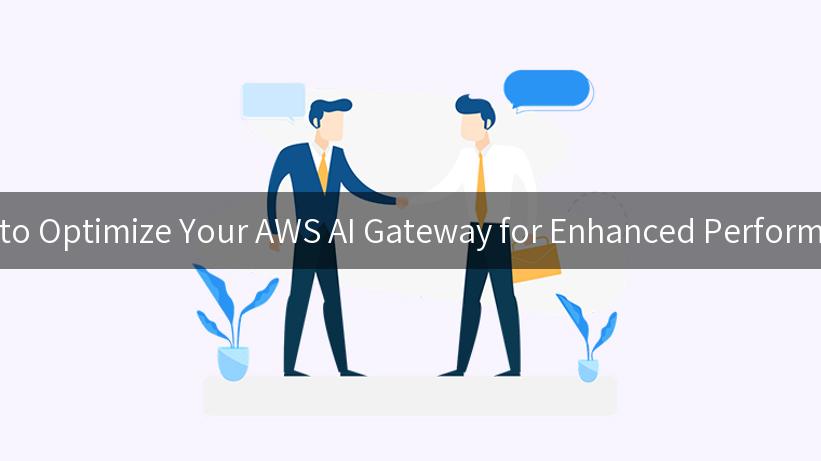
In today’s rapidly evolving technological landscape, businesses are increasingly turning to artificial intelligence (AI) solutions to boost efficiency and make data-driven decisions. AWS provides a robust infrastructure for implementing AI through its AI Gateway services. However, optimizing this gateway for enhanced performance is crucial. In this article, we will delve into various strategies to ensure that your AWS AI Gateway is not only functional but also optimized for peak performance.
Understanding AWS AI Gateway
The AWS AI Gateway serves as a gateway to connect various AI services hosted on the AWS platform. It allows developers to create and manage AI applications more efficiently by offering tools for API governance, scalability, and enhanced security controls. Before diving into the optimization techniques, let’s take a look at the primary components of an AWS AI Gateway.
Key Components of AWS AI Gateway
- API Management: Centralized management of API versions, security, and access controls.
- Scalability: Automatic scaling of services based on traffic patterns.
- Monitoring and Metrics: Real-time tracking of API performance metrics.
- Security: Implementing enterprise-grade security measures for accessing AI services.
The Need for Optimization
Optimizing your AWS AI Gateway is imperative for several reasons:
– Improved response times
– Increased user satisfaction
– Reduced operational costs
– Enhanced security measures
As organizations navigate the integration of AI, ensuring enterprise-safe usage of AI becomes a priority. This article outlines several steps to optimize your AI Gateway, ensuring that it is efficient and secure.
Strategies for Optimization
1. Optimize API Governance
API governance is critical to ensure that your AI services are well managed and secure. This involves establishing policies to monitor who can access the APIs and how they can be used. Implementing strict API governance helps minimize risks and ensures that only authorized users interact with sensitive information.
| Key Aspect |
Description |
| Authentication |
Use AWS Identity and Access Management (IAM) to set permissions. |
| Access Control |
Implement least privilege access controls. |
| Policy Enforcement |
Integrate API policies to monitor and enforce usage. |
2. Enhanced Security Measures
Security should never be an afterthought, especially when dealing with sensitive AI data. You can enhance the security of your AWS AI Gateway by:
- Implementing SSL/TLS for all API interactions to encrypt data in transit.
- Making use of AWS WAF (Web Application Firewall) to protect against common web exploits.
- Regularly reviewing IAM roles and policies to ensure that only necessary permissions are granted.
3. Load Balancing and Caching
Load balancing is necessary to ensure that your AI Gateway can handle a large number of concurrent requests without sacrificing performance. AWS offers a range of load-balancing options that can dynamically distribute incoming traffic, avoiding server overload.
Additionally, incorporating caching strategies can significantly speed up response times. By caching frequently accessed data, you can reduce the load on your backend services and improve overall performance.
# Sample Code for Implementing Load Balancer
aws elbv2 create-load-balancer --name my-load-balancer \
--subnets subnet-12345678 subnet-87654321 \
--security-groups sg-12345678
4. Monitoring and Analytics
Monitoring tools such as AWS CloudWatch are indispensable for tracking API performance. Set up alarms for any abnormalities such as high latency or a sudden drop in API calls.
Analyzing log data can help you identify performance bottlenecks and areas needing improvement. Additionally, make use of AWS X-Ray to trace and debug requests traveling through your API.
5. Scale with Auto-Scaling Groups
AWS Auto Scaling allows your AI Gateway to handle varying loads by scaling your instances up or down based on traffic patterns. It uses historical data to predict future traffic and pre-emptively scales resources accordingly, ensuring that your services remain available and responsive.
6. Integrate with Other AWS Services
AWS has a rich ecosystem of tools that can optimize your AI Gateway. Consider integrating services such as Amazon S3 for storage, AWS Lambda for serverless computing, and Ruby on Rails for rapid application development.
Diagram of an Optimized AWS AI Gateway
Below is an illustrative diagram to represent a well-optimized AWS AI Gateway architecture:
+------------------+
| |
| Users |
| |
+------------------+
|
|
+-------------+
| API |
| Gateway |
+-------------+
|
+-----------------------+
| |
+----------+ +----------+
| Load | | Cache |
| Balancer | | |
+----------+ +----------+
| |
+--------+--------+ +--------+--------+
| | | |
+---------+ +---------+ +---------+
| AI | | Lambda | | S3 |
| Service | | Functions | | Storage |
+---------+ +---------+ +---------+
APIPark is a high-performance AI gateway that allows you to securely access the most comprehensive LLM APIs globally on the APIPark platform, including OpenAI, Anthropic, Mistral, Llama2, Google Gemini, and more.Try APIPark now! 👇👇👇
Conclusion
Optimizing your AWS AI Gateway is paramount to ensuring a seamless, efficient, and secure integration of AI within your organization. Implementing critical strategies such as API governance, enhanced security measures, load balancing, and monitoring can propel your AI initiatives forward while ensuring compliance with enterprise security standards.
As more businesses leverage Azure and AWS for their AI solutions, standing out with an optimized gateway can lead to significant competitive advantages. Take the steps today to fortify your AI services and reap the rewards of an optimized AWS AI Gateway ecosystem.
By focusing on these vital areas, businesses can ensure that they not only utilize the capabilities of AWS AI Gateway to their fullest extent but also maintain a secure environment conducive to innovation and growth.
Let’s embark on this journey towards harnessing the full power of AI while prioritizing security and performance!